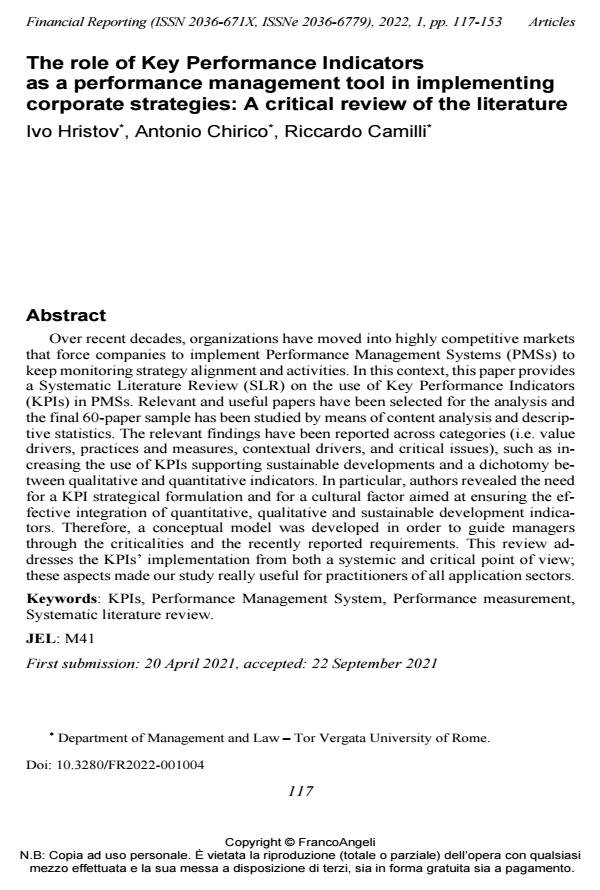The role of Key Performance Indicators as a performance management tool in implementing corporate strategies: A critical review of the literature
Journal title FINANCIAL REPORTING
Author/s Ivo Hristov, Antonio Chirico, Riccardo Camilli
Publishing Year 2022 Issue 2022/1
Language English Pages 35 P. 117-151 File size 211 KB
DOI 10.3280/FR2022-001004
DOI is like a bar code for intellectual property: to have more infomation
click here
Below, you can see the article first page
If you want to buy this article in PDF format, you can do it, following the instructions to buy download credits

FrancoAngeli is member of Publishers International Linking Association, Inc (PILA), a not-for-profit association which run the CrossRef service enabling links to and from online scholarly content.
Over recent decades, organizations have moved into highly competitive markets that force companies to implement Performance Management Systems (PMSs) to keep monitoring strategy alignment and activities. In this context, this paper provides a Systematic Literature Review (SLR) on the use of Key Performance Indicators (KPIs) in PMSs. Relevant and useful papers have been selected for the analysis and the final 60-paper sample has been studied by means of con-tent analysis and descriptive statistics. The relevant findings have been reported across categories (i.e. value drivers, practices and measures, contextual drivers, and critical issues), such as increasing the use of KPIs supporting sustainable de-velopments and a dichotomy between qualitative and quantitative indicators. In particular, authors revealed the need for a KPI strategical formulation and for a cultural factor aimed at ensuring the effective integration of quantitative, qualita-tive and sustainable development indicators. Therefore, a conceptual model was developed in order to guide managers through the criticalities and the recently reported requirements. This review addresses the KPIs’ implementation from both a systemic and critical point of view; these aspects made our study really useful for practitioners of all application sectors.
Keywords: KPIs, Performance Management System, Performance measurement, Systematic literature review
Jel codes: M41
- Mandatory non-financial disclosure: is everybody on the same page about business model reporting? Laura Bini, Stefan Schaper, Lorenzo Simoni, Francesco Giunta, Christian Nielsen, in Accounting Forum /2023 pp.198
DOI: 10.1080/01559982.2023.2170036 - Workplace Inclusivity: A Literature Review From a Strategy-As-Practice Perspective Sibongile Amy Katarina Mukupa, Matteo Cristofaro, Pier Luigi Giardino, in CORPORATE GOVERNANCE AND RESEARCH & DEVELOPMENT STUDIES 1/2023 pp.61
DOI: 10.3280/cgrds1-2023oa15792
Ivo Hristov, Antonio Chirico, Riccardo Camilli, The role of Key Performance Indicators as a performance management tool in implementing corporate strategies: A critical review of the literature in "FINANCIAL REPORTING" 1/2022, pp 117-151, DOI: 10.3280/FR2022-001004